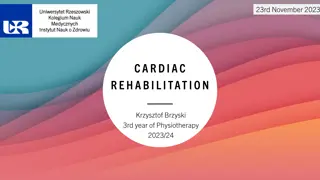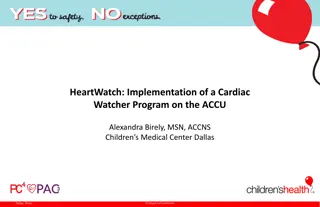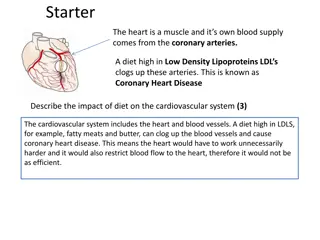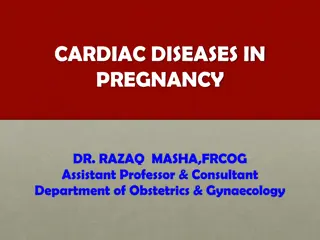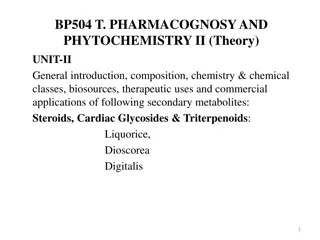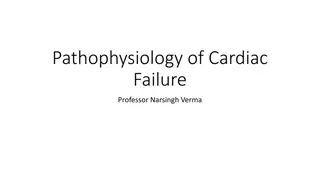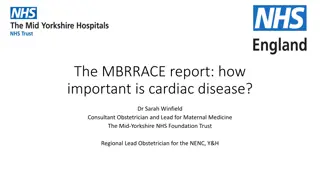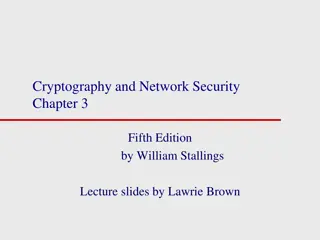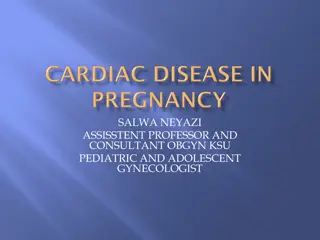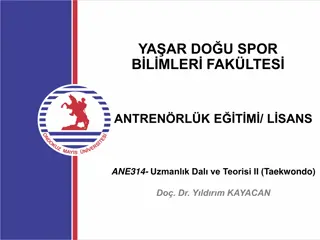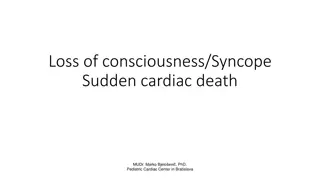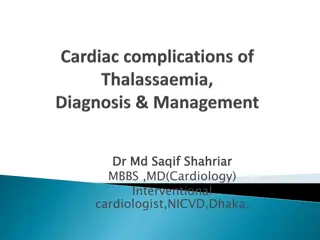Understanding Cardiac Electrical Activity in Physiology Team's Cardiovascular Block Lecture
Dive into the intricate details of cardiac electrical activity in this lecture led by Physiology Team 436. Explore topics like the cardiac conductive system, action potentials, refractory periods, excitation-contraction coupling, and the effects of autonomic stimulation on heart electrophysiology. Discover the essential properties of the heart for its functioning as the central pump of the cardiovascular system, including autorhythmicity, conductivity, excitability, and contractility. Gain insights into the specialized conduction system cells and contractile cells of the heart, outlining their distinct roles in cardiac function.
Download Presentation

Please find below an Image/Link to download the presentation.
The content on the website is provided AS IS for your information and personal use only. It may not be sold, licensed, or shared on other websites without obtaining consent from the author. Download presentation by click this link. If you encounter any issues during the download, it is possible that the publisher has removed the file from their server.
E N D
Presentation Transcript
Cardiac Electrical Activity Cardiac Electrical Activity Red: very important. Green: Doctor s notes. Pink: formulas. Yellow: numbers. Gray: notes and explanation. Physiology Team 436 Cardiovascular Block Lecture 2 Lecture: If work is intended for initial studying. Review: If work is intended for revision. 1
Objectives Study Smart: focus on mutual topics. In this lecture we will first give an introduction to the AP adding to lecture 1- and then we will talk about these electrophysiological properties in detail. FEMALES OBJECTIVES Discuss the cardiac conductive system and its function. o Describe the action potential of the cardiac muscle and its components. o Define the refractory period and the excitation contraction coupling. o Discuss the control of excitation and conduction of the heart. o MALES OBJECTIVES State and define the main electrical and mechanical properties of the heart. o Explain the genesis of the resting membrane potential in the cardiac muscle cell and identify the ionic currents during the different phases of the fast-response and slow-response action potentials in the cardiac muscle cell. o Discuss pacemaker electrical activity. o Define ectopic pacemaker and explain the mechanisms of ectopic pacemakers. o Summarize the function of the different parts of the conducting system of the heart and describe the sequence of normal conduction in the heart. o Describe the effects of sympathetic and parasympathetic stimulation on the electrophysiological properties of the heart. o 2
ONLY IN MALES SLIDES How the Heart Performs its Function as the Central Pump of The CVS (Recall lecture 1) The 2 main types of cells in the heart: 1. Cells of the specialized conduction system: non-contractile cardiac cells (but they initiate action potential by: constitute the tissue of SAN, the atrial internodal tract, AVN, the bundle of His, and the purkinje system) - they are called autorhythmic cells- we will talk about it in slide #5 2. Contractile cells (myocytes; working cells) (contract - don t initiate their own action potential) Primary difference between these 2 cells (the specialized conduction system cells and the myocytes): Is the absence of myofibrils in specialized conduction system cells; thus, little or no contraction is seen. 3
Essential Heart Properties for its Functioning as the Central Pump of the CVS 1- Autorhythmicity (automaticity and rhythmicity) - Generating rhythmical electrical impulses (cardiac impulse) independent of any extrinsic stimulation . - Impulse generate in SA node (pacemaker of the heart). -The conduction system specialized cells of the heart carry cardiac impulses rapidly to the myocytes in the atria, and after a pause, to the myocytes in the ventricles. 2- Conductivity Electrophysiological properties of the heart 3- Excitability Mechanical property of the heart (mechanical response to excitation) 4- Contractility The atria contract about one sixth (1/6) of a second ahead (before) of ventricular contraction. (Why?) To allow filling of the ventricles before they pump the blood into the circulation (AV NODE) (if they contract simultaneously the ventricles will not fill adequately and will pump less blood than needed and air) Another special importance of the system is that it allows all portions of the ventricles to contract simultaneously, which is essential for the most effective pressure generation in the ventricular chambers. (On slide #24) 4
The Specialized Excitatory and Conductive System of the Heart The cells of the specialized conductive system are found in: The sinoatrial (S-A node): in right atrium Bachmann s Bundle (interatrial bundle) The internodal pathway (anterior, middle, and posterior) The atrioventricular (A-V node): between right atria and ventricle The atrioventricular bundle (Bundle of His) Left and right bundle branches Purkinje fibers: transports signals to all cells Bundle of his Remember! They do not have myofibrils (actin & myosin) so they will not contract. Video of (SA Node) Duration: (0,59 secs) 5
ONLY IN MALES SLIDES Resting Membrane Potential (RMP) Resting membrane potential: is an intracellular potential of the resting myocyte and is found to be 80 mV to 90 mV (80 to 90 mV lower than the extra cellular potential). In atrial and ventricular cells: this RMP is stable until external stimulation (excitation) is applied. In sino-atrial node cells(in particular)and many conduction fibers: the RMP is not stable, drifting towards zero at times. (this is because the SAN is never at rest as it doesn t require a stimulus) Electrical potentials arise from: Differences in the concentrations of ions across the membrane. The presence of selective ion-conducting channels spanning the membrane, namely K+, Na+, and Ca2+. 1. 2. Resting Ventricular Myocytes In resting conditions: membrane is permeable to K+ only. K+ diffuses out of cell (efflux) down a concentration gradient. Negatively charged ions (phosphate and proteins) cannot leave cell creating negative intracellular charge RMP is due to K+ efflux Intracellular concentration Extracellular concentration Na+: 10 mM/L K+: 140 mM/L Ca++: 0.0001 mM/L Na+: 140 mM/L K+: 4 mM/L Ca++: 1.2 mM/L Ion pumps and exchangers establish differences in ions concentration across the cell membrane. 6
ONLY IN MALES SLIDES Potassium Equilibrium Potential Potassium : is the generator of the resting membrane potential. In resting conditions : membrane is permeable to K+ only. Intracellular concentration of K+ is 140 and extracellular concentration is 4 efflux of K+ down concentration gradient. This causes the intracellular charge to be negative due to : K+ efflux negative intracellular ions (mainly organic phosphates and intracellular proteins) not being able to accompany the K+ ions. As potassium is being diffused out of the cell, a point is reached where The number of K+ ions diffusing out of cell down concentration gradient = number of K+ ions pulled into cell by the negative intracellular charge. This point is called potassium equilibrium potential* . *Extra explanation: . . ( ) . 1. 2. . ) ( . Potassium equilibrium potential. 7
ONLY IN MALES SLIDES The Nernst Equation It describes: the balance of electrical and chemical forces across a cell membrane We can use Nernst equation to calculate the Potassium Equilibrium Potential Em = (equilibrium potential for particular ion) [X]e = concentration of ion in ECF [X]i = concentration of ion in ICF [X]e Note the subscript e is usually replaced by o . Em = 61.5 log10 [X]i According to Nernst equation: Membrane permeable to potassium: EK = 61.5 log10 4 = -95 mV 140 EK to K+ = -95 mV RMP = -90 mV We can conclude from the values that the RMP is mainly due to potassium efflux and not sodium influx. But if RMP is caused by K efflux, why aren t they equal? RMP increased because small amounts of Na diffused into cell. The diffusion of Na is called background currents Membrane permeable to sodium: ENa = 61.5 log10 140 = +71 mV 10 8
ONLY IN MALES SLIDES Cardiac Action Potentials: Excitability Excitability : is the electrical response to excitation (stimulation). When an excitable tissue is excited, it responds by generating action potentials. Cardiac action potentials can be broadly classified into two types, termed: 1. Fast-response. 2. Slow-response potentials. 9
Action Potentials from Different Areas of the Heart (This slide is an explanation for the next slide) overshoot MEMBRANE POTENTIAL (mV) Also called pacemaker potentials Absolute refractory period relative refractory period Supranormal period X axis time Y axis voltage 10
ONLY IN MALES SLIDES Major Differences Between Fast-Response and Slow-Response Action Potentials Fast Response Action Potential Slow Action Potential Found in 1. Atrial 2. Ventricular 3. His-Purkinje cells All phases of action potential are present (0/1/2/3/4) (phases will be explained in next slide) 1. Sinus node 2. Atrioventricular (AV) node Phases 1 & 2 are absent (phase 0/3/4 are found) Phases found Stable; voltage is constant (unless stimulus applied) Unstable; voltage slowly decreases (decreases negativity) (drifting towards zero with time) (there is spontaneous depolarization) Slower initial depolarization, lower amplitude overshoot Resting membrane potential (Phase 4) Phase 0 Rapid depolarization with a substantial overshoot (positive inside voltage) Phase 1 - Early partial repolarization - A rapid reversal of the overshoot potential Absent Phase 2 Long plateau Absent Phase 3 Repolarization Repolarization Phase 4 Stable , resting membrane potential Slowly depolarizing resting potential Conduction Velocity Rapid Slow 11
ONLY IN MALES SLIDES Fast-Response Action Potential Phase Phase 0 Very rapid depolarization Phase 1 Early partial repolarization Phase 2 Plateau Around 0 mV Due to Na+ influx through voltage-gated (fast) Na+ channels Inactivation of (fast) Na+ channels K+ begins to move out of cell Permeability of slow (ca+2) channels L-type calcium channels Chemical & Electrical forces of K+ & Ca2+ balanced; K+ out of cell = Ca2+ into cell Phase 3 - Repolarization Inactivation of slow (Ca2+) channels conductance of K+ out of cell Polarity of the cell interior becomes more (-) Phase 4 Resting state; RMP established Video of (AP of Cardiac Muscle) Duration: (15 mins) 12
ONLY IN MALES SLIDES Fast-Response Action Potential Mechanical Response 1 2 0 When AP reaches myocyte; calcium is released mechanical (contraction due to calcium release ) response 0 3 During Phase 2 - plateau: Catecholamines inward current of Ca (by phosphorylating DHPR) 4 Ca2+ channel blocker drugs inward current -90 TIME 13
ONLY IN MALES SLIDES Electrical Activity of The Pacemaker: Auto-rhythmicity The decay (decreased negativity) of pacemaker potential with time is caused by: Early stage Later stage A small current of Na+ flow into the cell. This current can be (if and ib): Membrane permeability to K+ gradually falls. As a result the outward background current ik falls progressively This will allow the inward currents (if and ib) to dominate increasingly. if ib Ca2+ current in the later part. As time passes, pacemaker potential decays (decreases in negativity) iCa K+ If a specialized pace maker current termed Ib the inward background current OUT IN Autorythmicity: ability of SA node to generate its own impulse The decay of SA node potential is the basis of autorythmicity f= funny channels: channels for sodium on SA membrane) iK Na+ Ca++ 14
ONLY IN MALES SLIDES Pacemaker Potential C D A B D. PK; PCa Opening of voltage- gated K+ channels Closure of voltage dependent Ca++ channels (L- type) B. PCa Opening of voltage- gated Ca++ channels (T -type channels) Closure of funny channels C. Opening of voltage- gated Ca++ channels (L-type channels) Closure of T- type Ca++ channels PCa A. PK ; PNa Closure of K+ channels. Opening of funny channels (Na+) f= funny channels: channels for sodium on SA membrane) Notice the differences between Slow action potential (pacemaker potential) and fast response action potential. For example: in Slow AP rapid depolarization is caused by Ca influx Fast AP rapid depolarization is caused by Na influx A+B = slow depolarization = phase 4 C= Rapid depolarization = Phase 0 D= Repolarization = Phase 3 P: permeability 16
ONLY IN MALES SLIDES Refractory Period Effective (absolute) Refractory Period (ERP) Relative Refractory Period (RRP) Follows ERP Depolarization possible with supra-normal stimulus Phase 3 to Phase 4 The cell is unable to be depolarized Phase 0 to portion of Phase 3 In SA node there is no refractory period because SA node does not respond to stimuli (since it generates its own impulse). In AV node there is a refractory period because AV node responds to stimuli from SA node. 17
ONLY IN MALES SLIDES Refractory Periods: Importance of the Long Plateau Long absolute (effective) refractory period will prevent cardiac muscles from being tetanized. ( ) The duration of the effective refractory period is approximately equal to the duration of the mechanical event. ) : . ( : ) ( ) ( . 18
Extra Information: Sometimes when there is an ischemia in the blood supply to the atria there will be fibrosis and this will affect the function of S-A node making it not functioning properly so, to solve this problem doctors will use artificial pacemaker for the patient. The impulses spread from the S-A node to the A-V node through the internodal pathway which is found in the right atrium. Atrioventricular node and delay of impulses conduction from the atria to the ventricles: The atrial conductive system is organized so that the cardiac impulse does not travel from the atria to into the ventricles too rapidly; this delay allow time for the atria to empty the blood into the ventricular before ventricular contraction begins. It is primarily the A-V node and its adjacent conductive fibers that delay this transmission into the ventricles. Causes of the slow conduction A-V node : The slow conduction in the transitional , nodal , and penetrating A-V bundle fibers is caused mainly by diminished number of gab junction between successive cells in the conducting pathway , so there is a great resistant to conducting of excitatory ions from one conducting fibers to the next. Therefore, it is easy to see why each succeeding cell is slow to be excited. 19
Conduction of Impulses: Conductivity 1. Sinoatrial / Sinus Node (SA Node) 2. Atrioventricular Node (AV Node) All slow response tissues have the ability to auto-activate (automaticity). Location: in the posterior wall of the right atrium. Location: in the superior lateral wall of the right atrium near the opening of the superior vena cava. Functions: Pacemaker of the heart Its rate of rhythmic discharge is greater than any other part in the heart. Highest frequency compared to other conduction parts and suppresses other pacemaker. [ Frequency ]: the number of heartbeats per minute. - SA Node Is capable of originating action potentials. - The AP is characterized by: diastolic depolarization - Slow depolarization of phase 4 - The impulses normally arise in it. - It controls excitation and conduction in the heart. Function: delay (stopping) in the conduction of impulses (0.1 sec). This allows time for the atria to empty the blood into the ventricles before ventricular contraction begin. So the atria contracts before the ventricle. Now it enters the atrio ventricular bundle to the perkinje fibers. What is a pacemaker? A pacemaker the part of an organ or of the body that controls any rhythmic physiological activity. Commonly being the sinus node in the human heart, and the resultant rhythm is a sinus rhythm. 20
ONLY IN FEMALES SLIDES Conduction of Impulses 3. The Purkinje system* Purkinje fibers are very large fibers. The Purkinje System Penetrates atrioventricular fibrous tissue (AV Bundle) divides into right and left bundle branches each branch spread toward the apex of the heart divide into small branches penetrate and become continuous with cardiac muscle fibers Transmit action potentials at a very high velocity (1.5-4.0 m/sec). Highest speed of conduction. Very high permeability of gap junctions ions are transmitted easily from one cell to the next enhance the velocity of transmission Ventricular muscle contract at almost the same time. *They are very large fibers, even larger than the normal ventricular muscle fibers, and they transmit action potentials at a velocity of 1.5 to 4.0 m/sec, a velocity about six times that in the usual ventricular muscle. 21
Spread of the Cardiac Impulse through the Heart ONLY IN FEMALES SLIDES ONLY IN MALES SLIDES *Highest frequency *Highest speed 22
ONLY IN MALES SLIDES Normal Conduction of the Action Potential in the Heart 1. AP is generated in the SA node 2. AP is conducted through the atria. 6. Rest 3. - Why AV node delays impulse for 0.1 0.15 seconds? to allow time for the atria to empty the blood into the ventricles before ventricular contraction begin - What controls the AV node conductivity? Sympathetic and parasympathetic stimulation -Conduction Very rapid. -Atrial cells are large. Contraction (apex to top) Fibrous septum 5. AP spreads through the ventricles (bottom/apex to top) - Ventricular cells are electrically coupled through gap junctions. Depolarization begins in Interventricular septum Spreads to right and left endocardial surfaces Spreads from endocardium to epicardium 3. Conduction slows at the AV node. -Small cells. 4. AP travels rapidly through the bundle of His and bundle branches 23 AV nodal delay s function is to keep ventricles in diastole while atria is in systole
ONLY IN MALES SLIDES Conduction Velocity (CV) in heart CV depends on: current spread diameter, more gap junctions faster conduction). Purkinje fibers: have very large diameter and more gap junctions with high permeability. AV node and bundle (Bundle of His): have small diameter and few gap junctions. Approximate CV: , hence, diameter and number of gap junctions between cells (larger ) ( Notice how the SAN is the fastest: SA node Atria AV node Bundle of His Purkinje system Ventricular muscle 0.05 m/sec 0.3m/sec (internodal pathway 1.0m/sec) 0.05m/sec 1 m/sec 4 m/sec 1 m/sec The high conduction velocity of Purkinje fibers is to ensure that the ventricular myocytes contract at almost the same time. 24
Abnormal Pacemakers (Ectopic Pacemakers) -out of place- Ectopic beat: A beat generated outside the normal pacemaker (S-A node). Ectopic focus (foci pl.) or Ectopic pacemaker. The site that generates an ectopic beat. Example: A- V node (atrioventricular node) block: The cardiac impulse fails to pass from atria into the ventricles The atria continues to beat at the normal rate of rhythm of the S-A node Ectopic Pacemaker causes : A new pacemaker develops in the Purkinje system with new rate.(ventricular escape) Blockage of transmission of the cardiac impulse from the sinus node to the other parts of the heart Other part of the heart develop rhythmical discharge rate that is more rapid than that of the sinus node In AV block: Atria still have SA node as pace maker Ventricles develop new pacemaker Example: A-V node or Purkinje fibers Example: AV Block 25
Control of the heart Rhythmicity and impulse conduction by the cardiac nerves The heart is supplied with both sympathetic and parasympathetic nerves (which are controlled by cardiac center in the medulla oblongata). Nerve supply of the heart Parasympathetic (vagal) Sympathetic Mainly to the S-A and A-V nodes All parts of the heart with strong supply to the ventricles atria + ventricles + blood vessels + smooth muscles of blood vessels Video of (Autonomic Innervation of the Heart) Duration: (4 mins) 26
Cont. Parasympathetic (vagal) stimulation of the heart Sympathetic Stimulation of the heart Rate of rhythm of the S-A node ( heart rate ). Transmission (conduction) of impulses to the A-V node. Rate of rhythm of the S-A node ( heart rate). Transmission (conduction) of the impulses to the A-V node. Force of contraction (+ ionotropic). Strong stimulation of the vagi: Stop the rhythmical excitation completely by the S-A node. Block transmission of cardiac impulses completely from the atria to the ventricle. Ventricular Escape: some point in the Purkinje fibers develops a rhythm of its own. Parasympathetic stimulation has no effect on the force of contraction because it does not supply the ventricles . The sympathetic stimulation has a crucial effect on the contraction because it supplies the ventricles. In strong stimulation of vagi (vagus nerve, vagal stimulation) the ventricles may stop beating for 5-20 sec, but then some small area in the purkinje fibers develop a rhythm of its own and causes ventricular contraction at 15-20 beats per minute , that s called VENTICULAR ESCAPE. 27
Quiz https://www.onlineexambuilder.com/cardiac-electrical-activity/exam-136804 Link to Editing File (Please be sure to check this file frequently for any edits or updates on all of our lectures.) References: Girls and boys slides. Guyton and Hall Textbook of Medical Physiology (Thirteenth Edition.) 28
Thank you! . The Physiology 436 Team: Team Leaders: Qaiss Almuhaideb Lulwah Alshiha Female Members: Rana Barasain Ashwaq Almajed Amal AlQarni Jawaher Abanumy Hayfaa alshaalan Lina alwakeel Male Members: Muhammad Al ayed Nasser Abu dujeen Contact us: Physiology436@gmail.com @Physiology436 29



